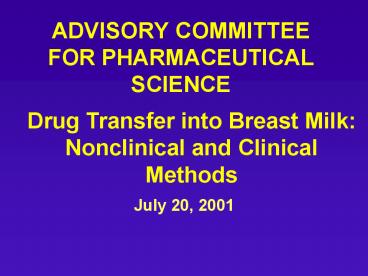July 20, 2001 - PowerPoint PPT Presentation
1 / 19
Title:
July 20, 2001
Description:
Sandra Suarez. Title of the Draft Guidance: Clinical and Non ... Parameters needed to calculate M/P values using the Log-transformed phase distribution model: ... – PowerPoint PPT presentation
Number of Views:58
Avg rating:3.0/5.0
Title: July 20, 2001
1
ADVISORY COMMITTEE FOR PHARMACEUTICAL SCIENCE
Drug Transfer into Breast Milk Nonclinical and
Clinical Methods
- July 20, 2001
2
- Outline of the Session
- Introduction and Background
- Larry Lesko, Ph.D.
- Draft Lactation Studies Guidance and Questions
Arzu Selen, Ph.D. - Nonclinical and Clinical Methods to Determine
the Amount of Drug in Breast Milk Advantages
and Areas - for Improvement Shinya Ito, M.D. and
- Pat McNamara, Ph.D.
- Questions and Panel Discussion
3
Draft Lactation Studies (Drug Transfer into
Breast Milk)Guidance
- Arzu Selen, Ph.D.
- FDA/CDER/OPS/OCPB/DPE III
- for the Lactation Studies Working Group
- July 20, 2001
4
Lactation Studies Guidance Working Group Chair
Arzu Selen Dee Kennedy Jurgen Von Bredow
Kathleen Uhl Pam Chamberlain Holli
Hamilton Margaret Bash Charles Bonapace Anita
O'Connor Jen DiGiacinto Peggy Miller Jerry
Fetterly Bill Rodriguez John Hunt Jooran
Kim Alfredo Sancho Sandra Suarez
5
Title of the Draft GuidanceClinical and
Non-clinical Studies on the Transfer of Drugs
and Biological products into Breast Milk
Driving Force
6
Objectives of the Draft Guidance
- Provide information on the amount of drug (and
its significant metabolites) in breast milk as a
percentage of - the maternal dose or
- the approved infant dose (if available)
- Provide clinically meaningful dosing
recommendation for the women who would be
breast-feeding .
7
In vitro methods, e.g. mammary cell
cultures, equilibrium dialysis
8
- Focus this morning
- Committee and panels view on
- the usefulness of measuring drug (and/or its
significant metabolite) in breast milk - the reliability of methods used for determining
the amount of drug in breast milk
9
Factors influencing drug exposure in infants
- Transfer and sojourn of drug in milk (mammary
drug pharmacokinetics) - Maternal drug pharmacokinetics
- Infant drug pharmacokinetics
10
Drug transfer into breast milk
Facilitated Diffusion
Active Transport
Diffusion
(model for further consideration
log-transformed phase distribution model)
11
- Parameters needed to calculate M/P values using
the Log-transformed phase distribution model - pKa,
- log P,
- protein binding
- H.C. Atkinson and E.J. Begg, Clin.
Pharmacokinet., 18, 151-167, 1990.
12
Using M/P (milk/plasma ratios) Amount of drug
in breast milk maternal Cavg x M/P x
milk intake Exposure Index milk intake x
(M/P)/Cl infant S. Ito and G. Koren, Br.J.
Clin. Pharmacol., 38, 99-102, 1994. where milk
intake 150 ml/kg/day or
0.1 ml/kg/min
13
- Questions for Panel Discussion
- 1. Is it important to estimate and/or to
determine the amount of drug (and/or its
significant metabolites) in breast milk? - a) For what type of drugs, is information on
the extent of drug transfer into breast milk
needed?
14
Questions (Continued) 1. b)When such information
is needed, when is it appropriate to estimate or
collect the data from non-clinical (such as
animal studies, in vitro studies) and/or
clinical studies? c) What parameters can be used
to assess the safety risk presented to
breastfed infants by drugs predicted to or
demonstrated to transfer into breast milk?
15
- Questions (Continued)
- 2. For drugs that are primarily transferred into
milk by diffusion, equations (such as log phase
distribution model) incorporating drug
characteristics (such as pKa, Log P, protein
binding) and distribution of drug in milk lipids,
are shown to be predictive of drug milk to
plasma (M/P) ratios. The M/P values are
ultimately used to predict the amount of drug in
breast milk.
16
Questions (Continued) 2. a) Would the Panel find
utilization of a model such as log phase
distribution model acceptable as a first
estimate for predicting the extent of drug
transfer into milk for all drugs? b) What
percent of drugs, an approximation, are
transferred into breast milk by processes
other than diffusion? c) What can be
considered as reliable screen(s) to identify
the potential of a drug to be actively
transported into milk?
17
- Questions (Continued)
- 3.The approach followed in calculation of M/P
values such as utilizing Area Under Curve (AUC)
ratios versus single point ratios can influence
the accuracy of this estimate. The accuracy of
M/P value is important as this value is further
utilized to calculate the amount of drug in
breast milk. - a)What are the advantages and limitations of
using M/P values (calculated based on AUC ratios)
to estimate the extent of drug transferred into
breast milk?
18
Questions (Continued) b) Are there other
acceptable approaches/methods for determining
the extent of drug transferred into milk?
Would milk drug concentration data alone
(instead of both milk and plasma drug
concentration data) be satisfactory to
determine the extent of drug transferred into
milk?
19
- Non-clinical and Clinical Methods
- to Assess Drug Transfer into Breast Milk
Advantages and Areas for Improvement - Shinya Ito, M.D.
- Pat McNamara, Ph.D.































